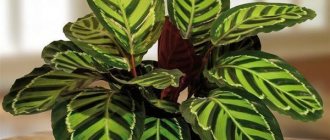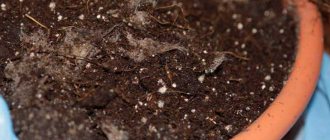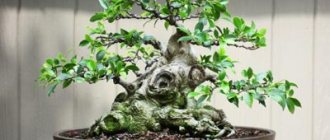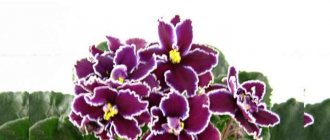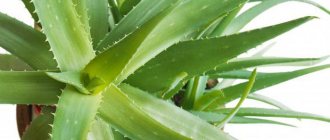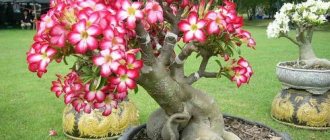Among the trees grown as a houseplant, one of the easiest to care for is the Ficus Benjamina Daniel. It grows quickly and is too large, but lends itself well to shaping, all types of weaving, and is easy to propagate. The attractiveness of the variety lies in its large, very dark leaves, like Ficus benjamina, which allows you to place the flower in the back of your home or office.
Photo gallery
The milky sap secreted by ficus is poisonous, so access to it by children and pets should be limited.
The plant helps purify indoor air from harmful substances, including ammonia, formaldehyde and benzene.
What does Ficus Benjamin Daniel look like, what family does it belong to?
Daniel (Danielle or Daniella) is a popular representative of the numerous genus of ficus. It has high decorative qualities, a simple and economical growing process. Leaf 6 cm long, dark green. The Ficus Benjamin variety is unpretentious. The elegant ficus Daniel, reminiscent of a dwarf tree, is a unique opportunity to transform both your workplace and home comfort. Graceful leaves edged in white. Soft flexible branches, a reliable beautiful trunk, extreme unpretentiousness in maintenance and care - this is not a complete list that characterizes an aesthetic plant.
Signs and superstitions
Ficus Daniel is able to benefit all household members. It helps improve a person’s emotional state and mood, relieves fatigue and depression.
The plant has the ability to influence people’s eloquence: those who find it difficult to express thoughts find it easier to conduct a dialogue, and overly talkative people learn to control their speech.
By planting a ficus in a green flowerpot, burying a few coins or bills in the soil and providing proper care, you can attract wealth and prosperity to your home.
A tree growing in a pink pot with hearts on it helps the owner find love or strengthen a marriage.
Married couples, placing a ficus tree at the head of the bed in the bedroom, can count on a quick pregnancy if they provide it with careful care.
What should I do after purchase?
You can buy ficus at any flower shop, or you can order it online. The price varies and can reach 12,000 rubles. As a rule, the cost directly depends on the height of the plant and pot.
- As soon as the ficus is in the house, it must immediately be placed in the place where it will grow.
- Leave him alone for about a month so that he can fully adapt to the new conditions, but you should not completely forget about caring for him.
- After the plant has gotten used to the new place, transplant it into a new pot, changing the soil and the transport pot.
Is the plant suitable for bonsai formation?
This variety of ficus has a fairly high growth rate and active branching, which allows you to give the crown the desired appearance and form a miniature bonsai from the tree.
To do this, you need to plant the plant in a small flat pot and trim the roots every six months, shortening them by a third. When the ficus reaches the required height, you need to pinch the top, stimulating the growth of the crown in breadth.
Also, due to the flexibility of the trunks in young specimens, it is possible to form stem systems in the form of braids, spirals or lattices.
Expert opinion
Mokhov Andrey Petrovich
Graduated from KubSAU, specialty: agronomy
Formative pruning can only be done in spring, during the growing season.
Trimming
Lady's slipper flower - description, care rules
Pruning and shaping the Daniel variety is a very exciting activity. They practically do not harm the plant, but, on the contrary, only benefit. The branches of the plant are quite flexible, so giving it the desired shape will not be difficult.
Note! Professionals plant several specimens in one pot. The trunks are intertwined and a single plant is obtained.
The best time to trim shoots is spring. The desired shape can be achieved thanks to the additional support of the wire frame. The growth of stems can be directed in the desired direction.
Home care
Lighting and comfortable place
The light should be bright, but diffused. Exposing ficus foliage to direct sunlight causes it to yellow and lose its natural shine.
The most suitable place is the east, west, southeast or southwest side of the room. In the summer, the plant can be taken out into the garden or onto the balcony, shading it during the midday hours.
When choosing a place where ficus Daniel will be located, you need to take into account that it does not tolerate drafts and frequent movements.
Air temperature and humidity
The optimal temperature in spring and summer is +20–25 °C, in winter – not lower than +15 °C.
Humidity should be around 70%. The minimum acceptable rate is 50%; with drier air, the plant withers and dies. Several times a week you need to spray the ficus crown and give it a warm shower every month.
If there is a possibility of a decrease in temperature, it is necessary to insulate the flowerpot and place it on a pallet, and cover the ground with polyethylene.
Spraying
Requires daily abundant spraying, especially during periods of low humidity: hot summer and heating season. To increase air humidity, you can place a saucer with water and expanded clay next to the ficus.
In the hot season, give the plant a shower - after that, do not rush to return it to the windowsill, but first let it dry a little so that sunburn does not appear on the leaves.
For spraying, use settled water at room temperature. Wipe dusty leaves regularly.
What kind of soil is needed?
The soil should be loose, nutritious, have good aeration and moisture capacity, and have neutral or weak acidity (pH 5.5–6.5).
You can use soil purchased at a specialized store and intended for growing ficus plants, or prepare a soil mixture yourself by mixing in equal parts:
Did you get a bonsai from Daniel?
Not really
- turf;
- leaf soil;
- coarse sand;
- peat.
To help the ficus take root, bone meal should be added to the substrate at the rate of 1 g per kg. soil.
You can disinfect the soil and get rid of pests and microorganisms in it using heat treatment or a manganese solution.
Transfer
The regularity of replanting depends on the individual characteristics of the ficus - the more intensively it grows, the more often it needs to replace the soil and flowerpot. On average, a young specimen needs to be replanted annually in the spring-summer period, a flower older than 4 years – once every 3-4 years.
The need for the procedure is indicated by:
- overgrown root system;
- presence of pests or diseases;
- unsuitable soil.
Also, a transplant is required at the end of the adaptation period after purchase.
For ficus Daniel, a pot made of porous material with drainage holes is suitable, the height of which should be about a third of the total size of the tree.
Expert opinion
Mokhov Andrey Petrovich
Graduated from KubSAU, specialty: agronomy
If the container is too large, the plant will direct all its energy to growing roots.
The most suitable method of transplantation is transshipment:
- At the bottom of the new pot, pour a layer of drainage consisting of pebbles, expanded clay or ceramic shards and sprinkle the prepared soil on top;
- water the plant generously and carefully remove it from the old flowerpot;
- place the ficus together with the earthen lump in the center of the new container;
- add soil, filling the voids, so that the root collar is flush with the ground;
- water the plant and place it in a warm, well-lit place.
Photo
Ficus benjamina "Daniel" photo:
Benjamin's ficuses are distinguished by their amazing ability to bring comfort and a favorable atmosphere to the home in which they are located. Our experts have prepared a selection of materials with photos and tips on growing the most popular varieties: Starlight, Kinky, Mix, Golden King, Anastasia, Baroque, Variegated and Natasha.
Reproduction
Ficus Daniel is propagated by cuttings, air layering and seeds.
By cuttings
The most common method at home, for which you need:
- prepare apical cuttings with growth buds and leaves;
- wash off the milky juice that appears, dry the sections and treat them with a growth stimulator - “Kornevin”, “Heteroauxin”;
- place the seedlings in a container with water, which subsequently needs to be changed every 2-3 days, or in a substrate consisting of equal parts of perlite or coarse sand and peat;
- cover the container with polyethylene and keep at a temperature of +22–25 °C, ventilating regularly.
The roots should appear after 2-3 weeks, after which the cuttings must be planted in separate flowerpots with soil suitable for adult ficuses.
Air layering
This method requires a woody shoot, at the edge of which you need to make an incision and remove part of the bark. Wash off the juice from this area, treat it with Kornevin, wrap it in damp sphagnum moss and cover it with polyethylene.
After 3-4 weeks, roots will begin to grow through the moss. After they appear, the resulting shoot should be cut off and planted in a separate container with a suitable soil mixture. This method can be used before the start of the growing season.
Seeds
First of all, planting material should be treated with a growth stimulator and fungicides (Fundazol). After this, sow the seeds on the surface of loose soil, cover the container with polyethylene or glass to create a greenhouse effect and place it in a well-lit place at a temperature of +22–25 °C, constantly ventilating and watering.
After 10–15 days, seedlings appear that need to be picked and later planted in individual flowerpots.
External description
Daniel is one of the varieties of Ficus Benjamin. The variety is distinguished by large dark green leaves up to 8 cm long.
The plant has the shape of a tree, but it often branches at the root, so it can easily be mistaken for a shrub. If you constantly prune the lower shoots, the tree will be standard, with one powerful and straight trunk and a lush crown.
Attention! The foliage changes color depending on age. Young leaves are lighter, but over time they darken and acquire a rich dark green color. If the crown of an adult plant is light and pale, this is a sign of disease.
Watering
The frequency of watering depends on the rate of drying of the top layer of soil - drying out the roots is detrimental to the plant, as well as waterlogging them.
As a rule, it is necessary to moisten the soil twice a week in summer and 2-3 times a month in winter.
The liquid flowing into the pan must be drained, otherwise there is a risk of developing root rot.
The water should be at room temperature, soft, and left for 24 hours.
If you are going on vacation
You can preserve moisture in the flowerpot for a while by laying hydrogel or damp sphagnum moss on the top layer of soil and covering the plant with polyethylene.
Diseases. Table
| Disease | Signs | Cause | Treatment |
| Powdery mildew | The appearance of white pellets on the leaf plates | Keeping at high temperature and humidity | Cut off the affected parts of the plant, treat with fungicides (Bona Forte, Storby) |
| Root rot | Withering and falling leaves, rotting roots | Excessive watering in combination with low air temperatures | Carry out a transplant, completely replacing the soil and flowerpot, remove all diseased areas of the root system, treat the ficus with the preparation “Maxim”, “Glyokladin” or “Discor” |
Problems with leaves. Table
| Problem | Cause | Solution |
| Premature yellowing and crown drop | Overwatering | Establish soil moisture regime |
| Intensive leaf fall | Lack of lighting, drafts, frequent changes of location | When daylight is short, use phytolamps, eliminate the possibility of drafts, do not move the flowerpot |
| The tips of the leaves have become dry and have acquired a brown tint. | Low air humidity | Spray the plant regularly |
Pests. Table
| Pest | Signs | Ways to fight |
| Mealybug | Yellowing of the crown, formation of white pellets on the leaves | Spray the plant with Fitoverm or Confidor |
| Spider mite | The appearance of white dots on the back of leaf blades and thin cobwebs on branches and leaves | Treat the tree with insecticides “Akarin”, “Omite”, “Apollo” |
| Shchitovka | The appearance of a sticky coating on the trunk and leaves | Moisten a piece of cloth or a cotton pad in a soap solution and remove insects mechanically, treat the ficus with “Aktara”, and a week later with “Confidor” or “Commander” |
| Aphid | The foliage becomes pale, a white coating appears on it, and begins to fall off over time. | Treatment with soap-alcohol solution and insecticides (“Akarin”, “Fufanon”) |
Possible difficulties during cultivation
When growing ficus Daniel, the gardener may encounter difficulties due to violations of care rules or the activity of pathogens and insects, for example:
- Falling of leaves due to excessive soil moisture and further acidification of the soil. Also, do not exclude the possibility of exposure to low temperatures or the addition of excessive amounts of nutritional compounds. Reviewing your actions will help solve the problem.
- Drying of the tips and yellowing of individual areas of the leaf blade. The reason should be sought in dry air. After increasing the humidity, the problem will be solved.
- The appearance of spots on the leaves due to prolonged exposure to the sun. Clearly visible light areas are burns caused by direct rays of the sun. Shade the plant in the afternoon or move the pot deeper into the room.
- Shredding of young leaves or their stunted growth indicates a lack of nutrients, so it is better for the grower to change the fertilizer or increase its dosage.
- Stagnation of moisture in a pot often contributes to the development of fungus , due to which the ficus weakens and loses its leaves. Fungal diseases can manifest themselves as mold, dark spots, gray or dark sooty coating on any part of the plant.
Common fungal diseases of ficus Daniel include:
- gray rot;
- sooty fungus;
- leaf fungus;
- root rot.
In any of these cases, the affected parts will have to be removed, and the remaining ones will have to be treated with fungicidal preparations (Fitosporin-M or Alirin-B).
Familiarize yourself with the features of growing these types of ficus:
Do not forget about possible pests of indoor vegetation, among which the ficus Daniel is especially afraid of aphids, scale insects, mealybugs, and spider mites. To begin with, in the fight against them, you can use a weak soap solution and washing the leaves under a warm shower, but if there are too many pests, then you will not be able to do without systemic insecticidal compounds, and it is better to purchase drugs like Actellik or Akara in advance.
Unfortunately, any indoor plant is at risk of disease or pest invasion, but if you create comfortable conditions for Ficus Daniel to grow and develop, while providing proper care, then there will be no problems with it. He will always delight you with a lush crown and attractive figures after a shaping haircut. In addition, ficus trees are famous for their cleansing capabilities and ability to rid your home of bad energy, and this is another reason to grow them in your home.

